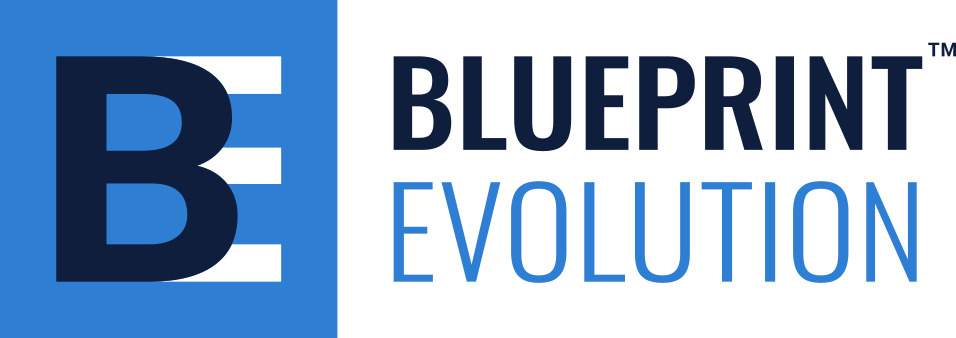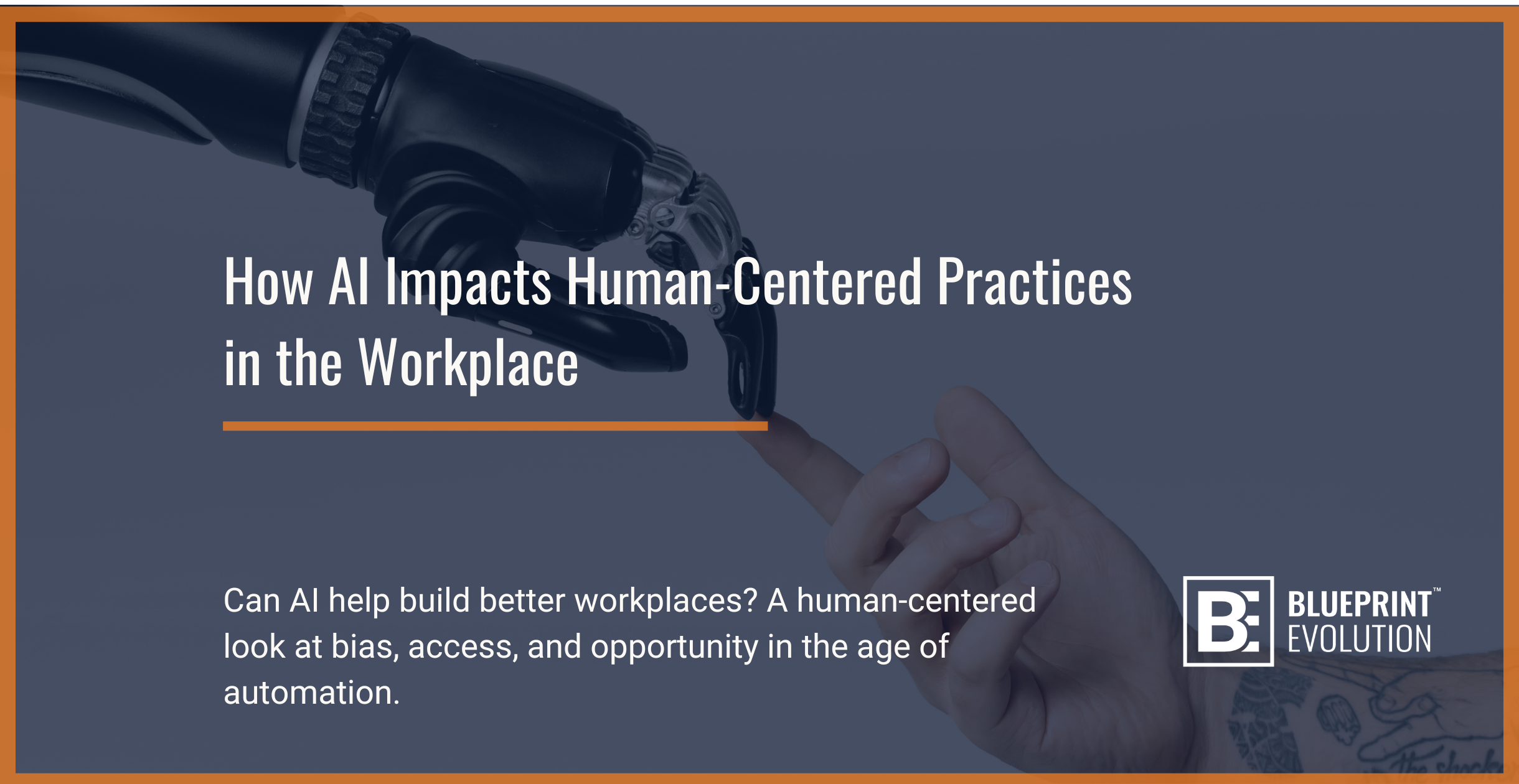Artificial Intelligence (AI) is transforming industries, reshaping business operations, and unlocking new possibilities. From boosting productivity to refining decision-making, AI offers a future where tasks are more efficient and tailored to individual needs. However, as this technology becomes increasingly embedded into organizational systems, a critical question arises: How will AI impact human-centered practices?
Human-centered practices—prioritizing conditions for everyone to thrive, embracing collaborative leadership, investing in employees’ holistic well-being, and ensuring clear communication and accountability—create the foundation for respect at every level of an organization and are vital to today’s workforce. Organizations strive to create cultures that support people from all backgrounds, experiences, and perspectives. AI has the potential to either support or hinder these efforts, depending on how it is developed and applied. In this blog, we’ll explore the risks and rewards of AI as it relates to human-centered practices and share key considerations for organizations adopting AI-powered tools.
The Challenges and Risks of AI in Human-Centered Practices
Unmitigated Bias in AI Algorithms
AI systems used in hiring, promotions, and performance reviews are often trained on historical data. If that data reflects past biases, the AI can learn and reinforce those same patterns. For instance, if a hiring algorithm is based on previous recruitment patterns that favored certain demographics, it may continue favoring those groups regardless of qualifications. Without intentional oversight, AI may deepen the inequities that organizations aim to eliminate.
Amplifying Inequities
When AI is used to automate human decision-making, it can obscure underlying biases—making them more difficult to identify and address. This can exacerbate existing disparities, particularly for historically marginalized groups such as women, communities of color, and people with disabilities, and further hinder efforts to achieve equitable outcomes.
Unequal Access to AI-Powered Opportunities
AI has the potential to offer personalized learning, job matching, and career development resources. However, these tools are not always equitably accessible. Those without reliable access to technology, training, or education may be left behind, making it harder for them to benefit from AI advancements and limiting professional growth opportunities.
Widening the Digital Divide
Geographic location, economic inequality, and lack of infrastructure all contribute to disparities in access to AI tools. If AI-based career tools or professional development platforms aren’t available to everyone, this digital divide can further entrench existing inequalities.
Lack of Transparency in AI Systems
AI decision-making often happens within a “black box”—with algorithms that are difficult to interpret or explain. Without clarity about how decisions are made, employees may feel powerless or distrustful, especially when outcomes appear unjust or biased.
Erosion of Trust
When people don’t understand how or why AI decisions are made, trust erodes—both in the technology and in leadership’s commitment to fairness. This distrust can be particularly strong among employees who already face marginalization, who may feel even more vulnerable when opaque, automated systems make decisions.
The Positives: How AI Can Advance Human-Centered Practices
Reducing Human Bias in Decision-Making
AI, when carefully designed, can help reduce the role of human bias in hiring, evaluation, and promotion decisions. By focusing on objective data, like skills, experience, and performance, AI can support fairer, more consistent decision-making processes that align with human-centered values.
Data-Driven Objectivity
AI presents powerful opportunities to analyze large datasets and uncover meaningful patterns in candidate and employee performance that might otherwise be missed. When thoughtfully designed and responsibly monitored, it can help mitigate bias and promote more equitable, data-informed decision-making. By focusing on objective criteria, AI can expand access to opportunities for individuals who are often overlooked in traditional processes shaped by unconscious bias.
Improving Inclusivity in AI Development
To support human-centered practices, AI must be developed in an inclusive manner. This means involving diverse teams—engineers, ethicists, and individuals from underrepresented and minoritized communities—to identify and prevent potential biases in algorithms from the outset.
Inclusive Teams Create Inclusive Tools
Diverse development teams are more likely to consider a broader range of use cases and user experiences. Their perspectives help create AI systems that serve all employees better and support inclusive outcomes, ultimately building trust across the organization.
AI as a Tool for Bias Detection
AI can help identify inequities that might otherwise go unnoticed. By analyzing hiring trends, pay equity, promotion patterns, and performance data, AI can surface disparities and provide organizations with actionable insights to correct systemic issues before they become entrenched.
Continuous Monitoring and Feedback
AI systems can flag trends in real time, such as skewed performance evaluations or pay discrepancies. This ongoing feedback loop allows organizations to respond quickly and uphold their human-centered commitments.
Building Trust in AI: Transparency and Communication
For AI to truly support human-centered practices, organizations must commit to transparency, fairness, and clear communication.
Transparent AI Policies
Organizations should clearly communicate how AI is used—particularly in hiring, evaluations, and advancement processes. This openness signals a commitment to responsible, ethical use of technology.
Clear Accountability
Employees must know who is responsible when they believe an AI-driven decision is unfair. Human oversight and accountability are essential to ensure that technology doesn’t replace empathy or responsibility.
Inclusive Education and Development
It is crucial to provide employees with training on how AI works and its impact on their work. When people understand the systems they interact with, they feel more empowered and can better advocate for their needs within an AI-enhanced workplace.
Moving Forward: Aligning AI with Human-Centered Values
AI is a powerful tool—but it is neither inherently fair, empathetic, nor inclusive. Its impact is shaped entirely by the values, choices, and oversight embedded in its design and use. To ensure AI strengthens—rather than undermines—human-centered practices like equity, well-being, transparency, and collaboration, organizations must:
-
- Identify and mitigate algorithmic bias
- Ensure equitable access to AI tools and training
- Prioritize transparency and accountability
- Involve diverse voices in AI development
- Use AI proactively to detect and address inequities
By taking these steps, organizations can ensure that AI not only drives efficiency—but also reinforces a workplace culture rooted in empathy, equity, and respect for the individual.







